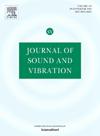Reference-free impedance-based crack detection for asymmetric structures: application to tidal turbine blades
IF 4.3
2区 工程技术
Q1 ACOUSTICS
引用次数: 0
Abstract
Impedance-based technique is a promising approach for structural health monitoring due to its high sensitivity to minor local damage, real-time monitoring capability, and cost-effectiveness. Traditional impedance-based methods rely on comparing the current impedance signal with a reference state, however the baseline characteristics may fluctuate under varying and noisy conditions, resulting in unreliable detection. An existing study proposed a reference-free impedance-based method by directly analyzing current-state impedance responses, allowing robust long-term monitoring by eliminating the need for baseline data. However, this method faces challenges for asymmetric structures, where additional mode conversions can obscure damage signatures and cause false detections. This study proposes an improved reference-free approach that enhances damage detection by extracting damage-sensitive features while filtering out irrelevant mode conversions. Numerical simulations on asymmetrical plate structures and a tidal turbine blade demonstrate the effectiveness of the proposed method, which consistently outperforms the existing reference-free technique, particularly in detecting minor damage in asymmetrical structures under highly damped and noisy conditions. The proposed method can be applied to a diverse range of structures, and its robustness and ease of implementation make it a promising solution for long-term structural health monitoring in complex environments.
基于无参考阻抗的非对称结构裂纹检测:在潮汐涡轮机叶片上的应用
基于阻抗的结构健康监测技术因其对局部损伤的高灵敏度、实时监测能力和成本效益而成为一种很有前景的结构健康监测方法。传统的基于阻抗的方法依赖于将电流阻抗信号与参考状态进行比较,然而基线特性在变化和噪声条件下可能会波动,导致检测不可靠。现有的一项研究提出了一种基于无参考阻抗的方法,通过直接分析当前状态的阻抗响应,消除了对基线数据的需求,从而实现可靠的长期监测。然而,这种方法面临着非对称结构的挑战,其中额外的模式转换可能会模糊损伤特征并导致错误检测。该研究提出了一种改进的无参考方法,通过提取损伤敏感特征来增强损伤检测,同时过滤掉不相关的模式转换。对非对称板结构和潮汐涡轮叶片的数值模拟表明了该方法的有效性,特别是在高阻尼和高噪声条件下检测非对称结构的微小损伤方面,该方法始终优于现有的无参考技术。该方法可应用于多种结构,其鲁棒性和易于实现性使其成为复杂环境下结构长期健康监测的有希望的解决方案。
本文章由计算机程序翻译,如有差异,请以英文原文为准。
求助全文
约1分钟内获得全文
求助全文
来源期刊

Journal of Sound and Vibration
工程技术-工程:机械
CiteScore
9.10
自引率
10.60%
发文量
551
审稿时长
69 days
期刊介绍:
The Journal of Sound and Vibration (JSV) is an independent journal devoted to the prompt publication of original papers, both theoretical and experimental, that provide new information on any aspect of sound or vibration. There is an emphasis on fundamental work that has potential for practical application.
JSV was founded and operates on the premise that the subject of sound and vibration requires a journal that publishes papers of a high technical standard across the various subdisciplines, thus facilitating awareness of techniques and discoveries in one area that may be applicable in others.
 求助内容:
求助内容: 应助结果提醒方式:
应助结果提醒方式:


